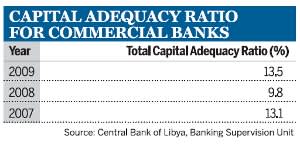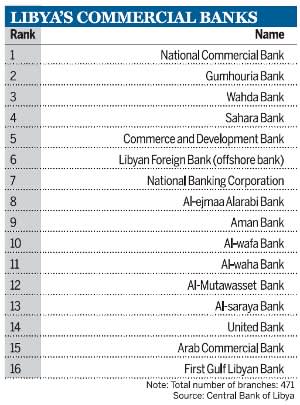Since the end of the sanctions era, the past five years have witnessed enormous changes in the Libyan economy and a strong determination on the part of the Central Bank of Libya (CBL) to build a viable financial sector while diversifying the country's economy. The CBL, well aware of the huge task at hand, but assisted by not only the limited impact of the global financial crisis and Libya's massive oil and gas reserves but also the $139bn that Libya holds in external assets, has embarked on significant structural reforms that are slowly but surely transforming its archaic, state-owned financial system.
Introducing competition
As a result of this, Libya is opening up. There are no more 100% publicly owned commercial banks, privatisations are taking place and foreign banks are being encouraged to acquire stakes in private banks. In just a few years, Libya's financial culture has been transformed, and at the time of writing, new banking licences for foreign banks are expected to be announced to further deepen and strengthen the competitiveness of the banking sector.
Earlier this year, six banks were pre-qualified for the two licences: the UK's HSBC and Standard Chartered Bank, Italy's UniCredit Group, Dubai-based Emirates NBD and Al Mashreq Bank, and Qatar Islamic Bank. HSBC and UniCredit - placed fifth and 17th, respectively, on The Banker's latest Top 1000 World Banks listings - are seen by analysts as the favourites for the licences. This move by the CBL will bring considerable competition to the country's banking system, as well as more financial products, global custodian services, and strong know-how to Libya's growing financial sector.
Libya's two largest commercial banks, Gumhouria Bank and National Commercial Bank (NCB), each sold 15% to the public through initial public offerings. The remaining 85% of both is still owned by the CBL. The CBL's medium-term privatisation strategy is to gradually phase out its holdings in Gumhouria, NCB and North Africa Bank (formerly National Banking Corporation) with the aim that the country's entire banking system will be in private hands by the end of 2011.
There are nine privately owned banks among the current list of 16 commercial banks in Libya, though none of these banks is a major player in the country.

Capital adequacy ratio for commercial banks
Foreign banks enter the fray
In 2009, the CBL allowed foreign banks to enter privately owned banks in Libya as strategic shareholders in order to improve their management and systems. Since then, three foreign banks have been allowed to hold strategic stakes, ranging from 40% to 49%, in Aman Bank, Al Mutawassit Bank and Al Muttahed Bank.
Meanwhile, the First Gulf Libyan Bank, a joint venture between Abu Dhabi's First Gulf Bank and the Economic Social Development Fund, began operations in November 2008 and the Libyan Qatari Bank, a joint venture between Libyan Foreign Bank and a Qatari holding company, has been licensed and is expected to start operations later this year.
Another development that shows Libya's efforts to strengthen its financial infrastructure lies in the establishment of the Libyan Credit Information Centre, which started operations in April 2009. This brought with it the introduction of a real-time gross settlement system, an automated clearing house and automated check processing, which are all now all operational.
Signs of improvement
In performance terms, Libyan banks are showing continuous improvement. As the table shows, customer deposits at Libyan banks almost doubled between 2007 and 2009, reaching approximately Ld40bn ($31bn) by the end of 2009. Loans showed a healthy 50% growth rate during the same period and Tier 1 capital adequacy showed steady growth, reaching 13.5% at the end of 2009.
In 2009, the loan-to-deposits ratio of Libyan banks was 18.4%, allowing room for more lending. Return on equity (based on earnings before taxes) was still strong at 25.9%, although down on 2008's impressive 34.2% return. While the non-performing loans (NPL) ratio remained high at 17.3% in 2009, it showed major improvement compared to a level of 26.6% at the end of 2007. Another positive factor is the high level of provisioning, which exceeded 88% of the amount of NPLs at the end of 2009. All the key figures and ratios are heading in the right direction and more improvement is expected, especially when foreign banks become more involved.
National commercial bank
National Commercial Bank, established in the late 1960s and the oldest commercial bank in Libya, clearly reflects the remarkable transition taking place in the country's banking sector, where banks are quickly moving away from the cumbersome state-owned model to a commercially driven, private sector-led focus. "Now we have competition and we are trying to attract customers," says NCB's chief operating officer Dr Fauzi Musbah Abokhzam, who has seen net profits at the bank almost triple since 2006 and increase 30% in 2009 to Ld115.7m ($91m).
NCB, which has about 700,000 bank accounts and 65 branches, has been in the forefront of the changes in Libya, and earlier this year, as part of the process to privatise much of Libya's banking sector, 15% of the bank was sold off to the public. Also, with the help of private consulting firms, Mr Abokhzam says that NCB has identified six key components of the new NCB business model.
Under the 2008 to 2011 road map, Mr Abokhzam expects to see total assets grow by 20% a year to reach Ld12.9bn by 2011, with loans expanding by 32% per year to reach Ld3.9bn by 2011 and capital and reserves estimated to reach Ld630m in 2011 (capital and reserves had risen to Ld500m at the end of 2009 following a Ld313m capital injection in February 2009).
Meanwhile, NCB views the Libyan banking market as underpenetrated compared to other north African countries and expects it to keep growing substantially. Besides the six pillars of the new strategy, which involve a new customer-oriented service model, product innovations, a new branch network, enhanced credit and risk skills and more, NCB is introducing a limited service in Islamic finance products and expanding both its ATM network and distribution of debit and credit cards.
At present, according to Mr Abokhzam, NCB has 31 ATMs but the bank expects to have close to 100 by the end of 2010. Rapid progress is also being made on card issuance, with 4000 debit cards being issued each month and a plan to have 60,000 debit cards issued by the end of 2010. NCB is also planning to issue 2000 Visa Gold credit cards and 5000 Visa Classic credit cards by the end of the year.
In addition, to improve its retail market share, now around 13%, NCB plans for 18 new branches to bring its total to 83 by the end of 2011. Emphasising the increased efforts to retain customers, Mr Abokhzam also notes that NCB's level of NPLs is 9%, well below the sector average, and the bank has recently introduced a new core banking system across the bank. NCB, like others, after years in the financial wilderness, is making dramatic reforms that are also beginning to show dramatic improvement in returns.

Libyan commercial banks' balance sheet

Libya's commercial banks












